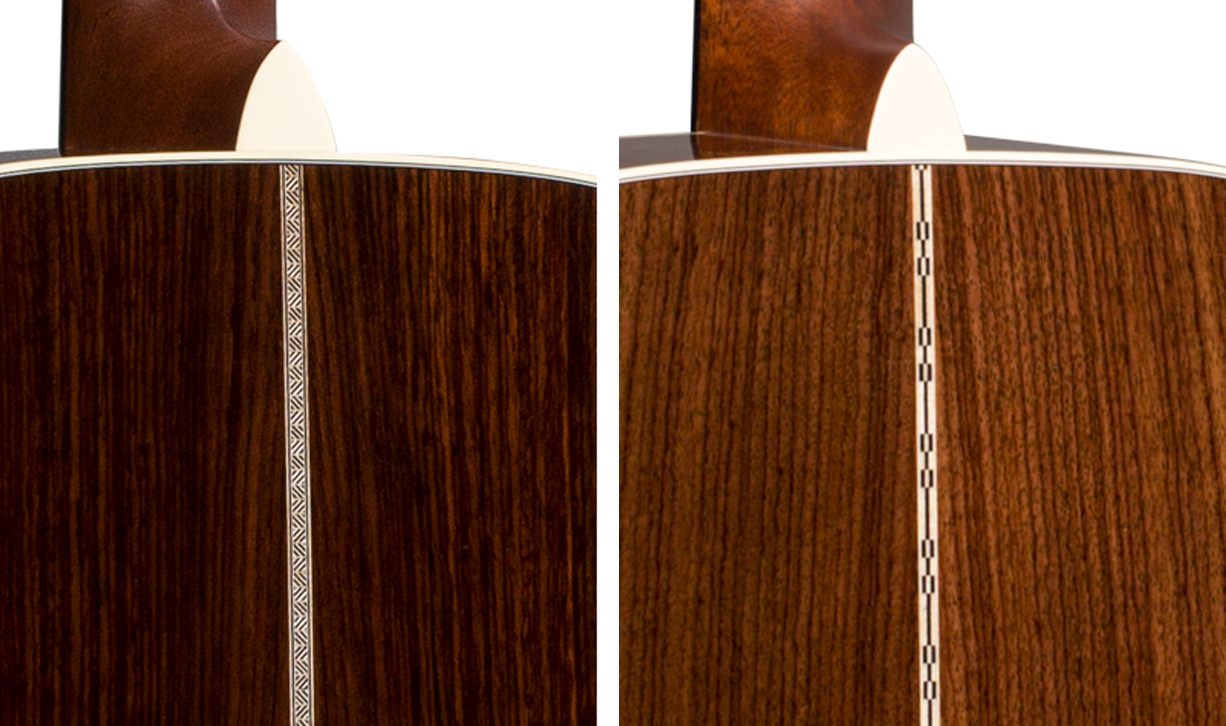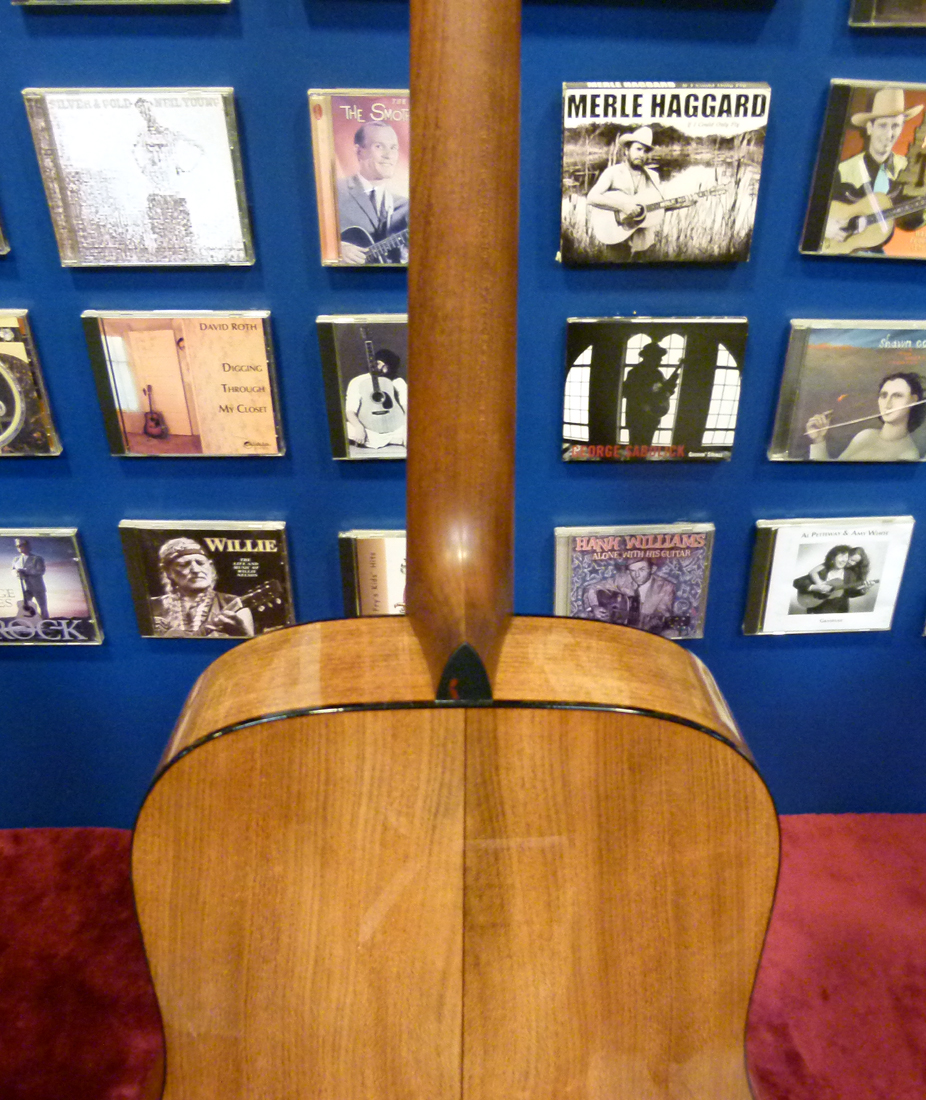Category: NAMM
Martin 000-28 (2018)
The long-awaited makeover of the Standard Series 000-28 arrives
The addition of scalloped bracing and Martin’s High Performance neck bring this short-scale 000 into the 21st century, while returning the appearance to a pre-World War II aesthetic
The in-depth written review of the 000-28 (2018) will appear once I produce the videos of the various 2018 Martins I recorded at the Martin factory on NAMM Day 2018.
Martin D-35 (2018)
The one many people have been curious to hear, the D-35 (2018) makeover is a winner
With the change to forward-shifted bracing the new it has a meatier undertone and slightly fatter trebles, but it is still a uniquely articulate dreadnought
The written reviews of all the new Martins will appear starting later this week. I am doing all the videos first for a change.
Martin D-45 (2018) A Top of the Line Makeover
Flagship of Martin’s Standard Series, the D-45 (2018) sets a new standard
Vintage aesthetics combine with the High Performance neck
The written review of this new Martin D-45 (2018) will appear after I produce the other Winter NAMM Martin videos. Stay tuned!
Martin HD-28 (2018) and About Time Too!
The NEW Martin HD-28 (2018) has pre-war looks and forward shifted bracing!
Combined with the High Performance neck
Since the mid-1990s people have said Martin’s Standard Series guitars should have the looks and sound of the Vintage Series guitars, especially those who kept saying, “I’d buy one if it didn’t have the V neck.” Well that is pretty much what has finally happened. So here ya go, Ladies and Gentlemen get your wallets ready!
WATCH ON YOUTUBE in HD1080 FOR THE BEST SOUND
The written review will follow in time, I am putting out the videos first this year, at least for Winter NAMM.
Martin Custom 000C-21 -TSP Artist Edition at Maury’s Music
Spoon Phillips designed this high-end rosewood 000 with a traditional short-scale neck and top-shelf features
Available exclusively at Maury’s Music
NOTE: This Limited Edition Martin Guitar Sold Out in 2020.
maurysmusic.com
Specs Include: All-solid tonewoods, Auditorium size body with hide glue construction throughout; Venetian cutaway; Guatemalan rosewood back and sides; Adirondack spruce top with Large Sound Hole, scalloped 1/4″ Adirondack spruce braces; short-scale Big Leaf mahogany neck with Low Profile shape; ebony fretboard with 12″ radius, 1-11/16″ bone nut; abalone Diamonds and Squares position markers; ebony bridge with compensated bone saddle and 2-1/8″ string spacing; Martin’s Authentic Series Thin Finish package; Vintage Style 21 appointments including 1940-era rosette, purfling and fret markers, 1910-era rosewood bindings, ebony bridge pins with ivoroid dots; Gotoh nickel open-back tuners; faux tortoise pickguard
While this guitar was designed to have the fastest, sleekest neck ever put on a Martin acoustic guitar, Maury’s Music will accept orders for this exact same short-scale 000C-21 TSP with the neck shape, nut width, fretboard taper, and string spacing of your choice. In the words of the artist who designed it, a guitarist should be able to have whatever neck best suited their comfort or desire.
Watch in 1080p for best sound
I could not possibly offer an objective review of this Martin guitar. I am the man who designed it to be just so, according to my likes and needs.
But I also designed it with an eye and, more importantly, an ear and a hand toward creating a unique musical instrument that would appeal to and be genuinely useful to artists who pick up acoustic guitars for many reasons beyond providing background rhythm for singing songs.
So I will leave further information about this instrument to Maury’s Music, who is offering this Martin guitar for sale as a Custom Artist Edition, designed by me, your humble Spoon, and made in Martin’s Custom Shop. It will officially be announced at Maury’s on the 25th, along with the rest of the new Martins available for sale at Maury’s Music.
And there is also the notice I put on my personal website, tspguitar.com for those who wish to learn more about this guitar in my own words. Here below is an excerpt.
Forty Years in the Making
It has been over 40 years since the Jackson Browne album, For Everyman, made its initial impact upon my young, impressionable ears. More to the point, it was the never flashy but always evocative guitar work provided by David Lindley on that record that schooled me in how a sideman can so enhance a song without overdoing it with superfluous fireworks. And it has been less than 40 years since I read the interview with where Lindley mentioned that his favorite recording acoustic guitar was a 000-21 from the early ’40s.
If I wasn’t already drawn to Martin’s Style 21 instruments because of their esoteric status and utilitarian yet beautiful aesthetics, with rosewood a bit too wild and woolly in its looks for the staid Martin Company’s ship-of-the-line 28s, Mr. Dave’s endorsement sealed the deal.
It has long been my dream to create a guitar that would prove genuinely versatile for a musician who played as much Jazz and Rock on their acoustic guitar as folk or fingerstyle, while having a tonal heart that would have been right at home at the Martin Guitar Company of the 1930s and ’40s.
And this instrument has exceeded my every expectation.
More New 2018 Martins Announced!
Martin D-45 models and a new Authentic make the cut among the 2018 Martins
Doesn’t look like anything from the lists I saw were put off til Summer. So there’s LOTS of new Martin videos soon!
Check back to see and hear these and all the new Martins starting next week!
In the meantime, there is a sneak preview of this soon to be released …
Martin 000C-21 TSP T Spoon Phillips Custom Artist-Dealer collaboration, which will be officially announced on January 25.
A 12-fret dreadnought with the High Performance neck! Ultralight build with Adirondack spruce over Big Leaf mahogany with hide glue construction, light-weight carbon fiber used for the pickguard, and in composite with torrefied Adirondack spruce for the bridge plate! As well as lightweight tuners and fabulous Liquidmetal® bridge pins that for the first time have lost their chrome appearance and look like bone.

D-42 Purple Martin third edition:
OK the previous two were done in similar Style 41. This one has the Style 42 pearl around the fretboard extension. Gorgeous inlays grace this stunning guitar made from highly figured katalox from the American tropics, which is harder than ebony, and heavily-bear clawed Engelmann spruce for the top!
Figured Engelmann spruce over Madagascar rosewood, with outrageous inlays by the one and only Harvey Leach that have an ice dragon on the headstock and a phoenix rising up the fretboard
Martin’s new cosmetic aging process is applied to the second edition of a D-45 Authentic that appeared the first year of the Authentic Series, which has an wider-than normal body and a honking huge neck, now with aged Adirondack spruce thanks to Martin’s Vintage Tone System, which wasn’t yet developed the first time around.
Like the 45 above, this D-18 Authentic with its classic mahogany and Adirondack build has the new cosmetic aging and will be “aged” one guitar at a time.
My mouth has watered for this model since I saw it on a list at Martin some time ago. And now I understand the wait, as it introduces torrefied Vintage Tone System mahogany to the Authentic Series!
OME Cherry FSC Certified Woods
Made entirely from woods certified by the Forestry Stewardship Council promoting responsible management of our precious natural resources, this Orchestra Model with on-board Electronics combines American cherry back and sides with a Sitka spruce top and European spruce bracing.
These are in addition to the D-45 John Mayer model and the forest of newly revised Standard Series Martins, see the links below!
Martin’s Standard Series Has Been Standardized For 2018
C. F. Martin & Co. unveils a “reimagined Standard Series” for Winter NAMM 2018
The D-45 gets new binding and Style 28 returns to its roots while embracing Martin’s vision of its future.
More New Old Martins
The entire Standard Series that defines Martin guitars to the world has been uniformly converted to vintage guitar aesthetics achieved by applying Aging Toner to the Sitka spruce tops. While the Standard Style 18 and 21 models retain the faux tortoise binding of their predecessors, those made in Style 28, 35, 36, 40, 41, 42, and 45 all sport the Antique White binding introduced on select models in recent years.
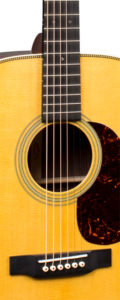 |
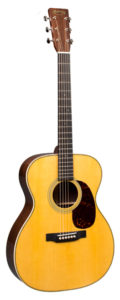 |
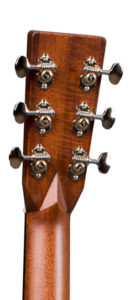 |
Photos: The 000-28 (2018) replaces the last hold-out of the old Standard Series (click to enlarge)
Gone are the stark white bindings and the last of the black pick guards. Gone too are the tops with the natural French vanilla color slowly yellowing across the years as sunlight tans them toward butterscotch and onto pumpkin orange as the decades roll by. The appearance of the Aging Toner has been formulated to fall somewhere between Martin’s previous offerings of vintage-esque hues, and lands more in the butterscotch spectrum than not. Many of the new Standard Series models can be ordered with a Sunburst top or an Ambertone top.
Diamonds in the Black
Similar to the makeover given to Standard Style 18 a few years back, which combined Martin’s modern High Performance Neck with the scalloped forward-shifted bracing, tonewoods, and open-back tuners of the old Vintage Series 18s, the domino dots and black and white line inlay of last year’s 28s have been retired in favor of the bold herringbone trim around the top, and the diamond position markers gleaming from the black ebony fretboards of the (soon to be) extinct Vintage Series 28s. And the entire Standard Series will likewise be getting the High Performance Neck. Their marketing data suggests it is the best way to guarantee Martin’s cash flow remains very much in the black.
The High Performance Neck combines a Modified Low Oval shaping to the neck itself with a fretboard that has the High Performance Taper, measuring 1-3/4” wide at the nut, and 2-1/8” at the 12th fret – specs that have become the industry standard among popular guitarmakers. It does appear that Martin has made its last 1-11/16” Low Profile neck, other than on possible future special or limited editions.
That the HD-28 was being remade with the HP Neck in the image of the HD-28V has been known to me for some time now. But whether they would be uniformly remaking all the 28s was an open question until quite recently.
As the man with his name on the headstock, CEO Chris Martin remains intimately involved with many of the decisions that lead to just which Martin guitars end up for sale and when they will appear before the public. For example, it was his fourth quarter decision to withhold certain models from last year’s Winter NAMM until the Summer show. And even then, the revamped Standard D-28 (2017) didn’t get the go light until the last minute.
I was among those holding my breath as to just what exactly would be the final specs of the new Standard Series Martins when they were displayed at the Winter NAMM trade show on January 25, 2018.
One interesting tidbit, the 00-28 and 000-28 are keeping the Style 28 back strip, while the others are moving to the vintagesque zig-zag back strip used on 28s in the pre-WWII years. I had to wait until today’s executive luncheon ended to confirm this is indeed the way things will be at NAMM.
According one of those well-fed execs, “If an H appears in the model name (i.e. HD-28,) then it will have a zig-zag back strip…if no H, it will get a checkerboard pattern,” which appeared on contemporary Style 28 models since the late 1940s.
Photos: A tale of two 28 back strips (click to enlarge)
The H designation once signified herringbone trim and scalloped bracing. In the new Style 28, some guitars with both of those features do not get the H. And yes this does mean the OM-28 (2018) has surrendered its 1930s zig-zag for the 1950s checkerboard. But it and most of the Standard Series instruments with (2018) in the name get an upgrade in tuners, to Schaller GrandTune™ machines. Style 35 guitars retain the chrome enclosed Grover Rotomatics associated with Style 35 throughout its lifetime.
It Is What It Is
Change often comes slowly at Martin Guitars, while some of their biggest fans have a hard time accepting any change at all.
The loss of grained ivoroid bindings from the OM-42 or the additions of Antique White binding and Aging Toner to the top-of-the-line D-45 may seem like sacrilege to some (who had no intention of ever buying a D-45 anyway,) but it is the change to forward-shifted bracing on the HD-28, D-35, D-41, and D-45 that may prove much more controversial in practical terms, just as it has been for the D-28 2017 model that appeared at Summer NAMM.
The term forward-shifted bracing refers to where Martin placed the X brace in relation to the bridge plate on Dreadnought models made in the 1930s. It is often said to be one inch from the sound hole, but it is all about the flexibility of the spruce soundboard around bridge plate, father down the top from the X, which matters. That is where the majority of the sound-producing energy is transferred from the guitar strings to the musical instrument.
The bracing was moved nearer the bridge plate sometime in 1938, to a position now called “rear-shifted bracing.” And then it was brought forward a little bit at a time until the late ’50s, when it reached the position that was considered the “standard position.” That is, until now.
Moving the center of the main X brace that little bit farther away from the bridge plate on a Dreadnought-size guitar increases bass response noticeably, while adding more echoy resonance to the voice in general.
Martin going all-in on forward-shifted bracing (not including 12-string models) will bring further uniformity to the Standard Series, while also severing ties with the Martins made in the final 40 years of the twentieth century, at least when it comes to the brace position. There is no doubt it changes the voice of a guitar. But it will be left to the individual guitarist as to whether that is a good thing or not.
Likewise, the Company is all in on the take-it-or-leave-it stance concerning the High Performance Neck.
While the playability and feel of the HP Neck allows their ship-of-the-line Martins to enter into direct competition with makers like Collings, Huss & Dalton, and Taylor Guitars, not all guitarists are happy with the new Martin neck. They will have to look to Martins outside of the Standard Series when seeking a vintage style V neck, or they must look to the Custom Shop if they want a new Martin with the Low Profile neck from the old Standard Series.
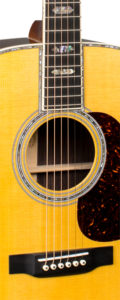 |
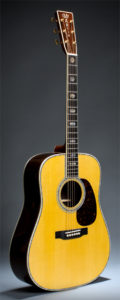 |
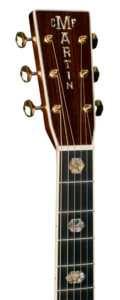 |
Photos: The new D-45 (2018) has vintage looks and modern construction (click to enlarge)
C. F. Martin IV’s Legacy
It can be argued that this reimagined Standard Series may be the most important event in the continued success of the Chris Martin’s family business, since his great-grandfather, Frank Henry Martin, brought the Company into the twentieth-century and piloted it through the Great Depression. It took many years of trial and error to bring all these specs into one unified collection of reasonably-priced, professional-level guitars.
Now in his 60s, today’s Mr. Martin is gearing up to follow his long-time friend Dick Boak into retirement. He will be remembered for leading his Company out of one economic slump and through several others, by embracing and respecting Martin tradition while also introducing and championing modern technologies, and alternate and environmentally responsible materials, often combining the traditional with the futuristic to break new ground that will prove to be sound bedrock for his business to build upon for many years to come.
For guitarists who long for Martin guitars made more like the old timers, he has provided the excellent Authentic Series of meticulous vintage Martin recreations. And for those who want Martin to boldly step outside of their tried and true designs, there are the many special editions and Chris’ own CEO Series.
And now, his transformation of the Standard Series that began with the D-18 makeover in 2012 has come to fruition. By infusing many aesthetic features of old Frank Henry’s pre-war Martins with the modern technology like the High Performance neck, made possible in part by Martin’s exclusive two-way adjustable steel truss rod, the effort to return Martin’s Standard Series to its rightful place as the industry standard for top flight acoustic guitars is fully realized. It may very well be among the wisest moves Chris Martin could make as he prepares for the on-coming century of Martin guitars.
Check back soon, as we will be writing about other new Martins as soon as I am given the permission to start blabbing!
In the mean time…
Check out the new Standard Series Martins and their public spec sheets below
All guitars listed have new specs, or are wholly new to the Martin catalog for 2018.
Martin D-45 John Mayer model announced for Winter NAMM 2018
A magnificent crown jewel in the guitarist’s series of Martin signature models, the D-45 John Mayer glitters gloriously
Intelligent combination of features produces 45 very special guitars
Limited to just 45 instruments, John Mayer designed this special edition for Martin’s 2018 offerings of new models that is also a special addition to his own series of Martin signature models, with some features that tie it into some the previous editions and others that make it wholly unique.
After two OMs and two 12-fret 00s, this is the first Mayer model made in the Dreadnought body size. And it continues the precedent set by the two 12-fretters by having the multi-ring abalone soundhole rosette continue across the black ebony fretboard, to complete the circle.
It is also the first Mayer model to feature Guatemalan rosewood for the back and sides. This is not the only special run of Martin guitars about to go on sale with that particular tonewood, but it is the largest.
The top is high-grade Engelmann spruce, with tonal properties that should meld and marry with those of the Guatemalan rosewood to produce an exceptionally lush and complex voice. And adding to that musical mojo are scalloped, 1/4″ Adirondack spruce top braces, forward-shifted like those found on vintage Martins. That should all make for one seriously resonant, rumbling, and roaring voice.
Other vintage-esque Martin features include the grained ivoroid bindings, open back tuners, and Aging Toner, which help give the appearance of a pre-war D-45, while a 1-11/16″ Full Thickness neck like that found on the resurrected D-45s of the late 1960s should provide a faster, less fist-filling fretting experience than the original old-timers.
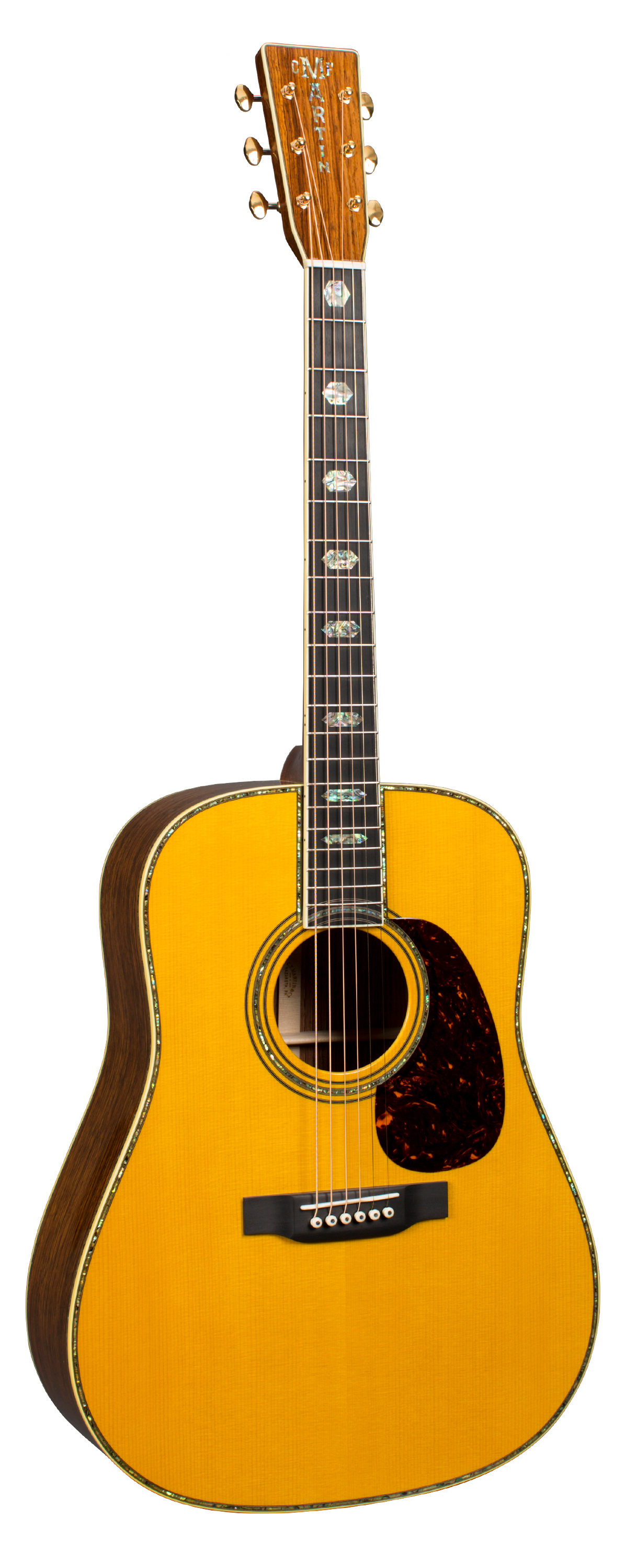 |
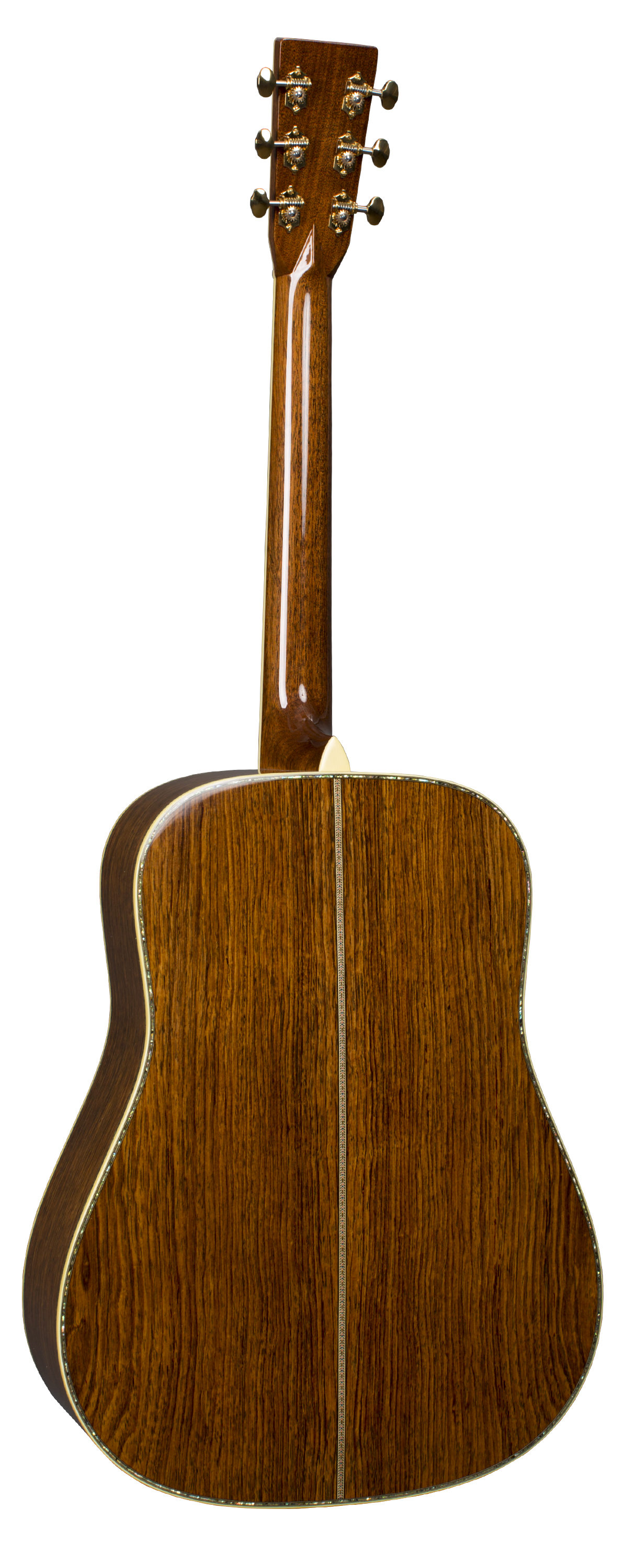 |
Check out the other photos and specifications at the D-45 John Mayer official listing at Martin Guitars.
And check back here in three weeks for our exclusive review with video of this and other new Martins for 2018!
Martin Model America 1 Review
Domestic tonewoods shine in the Model America 1
America’s premiere guitarmaker makes a premiere guitar from woods all made in America
Specs Include: Solid tonewoods with high gloss nitrocellulose finish, including sycamore back and sides, Adirondack spruce top, 5/16” forward-shifted scalloped Adirondack spruce braces; satin finished cherry High Performance neck with Modified Low Oval profile, and black walnut fingerboard with 1-3/4” width at the bone nut, 2-1/8” at the 12th fret; black walnut bridge with 2-5/32” string spacing at the compensated bone saddle; Corian dot fret position markers, Style 18 top trim and soundhole rosette; open-back tuners with butterbean buttons, faux tortoise shell binding and pick guard
“There is a firmness to the sycamore trebles and a fullness to the bass notes, and a chiseled definition to the center of the voice, thanks to the Adirondack spruce top. The Adirondack effect makes the center of the voice quite straightforward, leaving lots of space behind it, in that almost “vintage openness” sort of way.”
